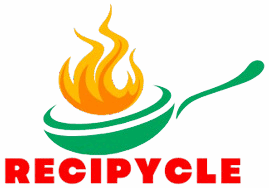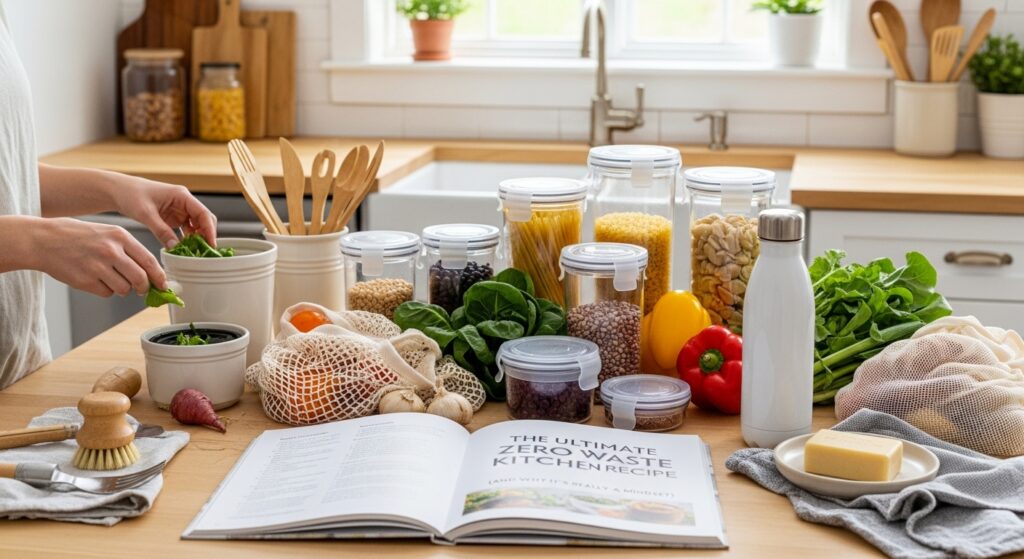
Here at Recipycle, we believe the best “recipe” is one that “recycles” what you already have. The truth is, a “zero waste kitchen recipe” isn’t a single set of instructions—it’s a new way of thinking.
It’s about seeing a lemon rind not as trash, but as future DIY cleaner. It’s seeing stale bread not as a lost cause, but as future croutons.
In my own kitchen, the biggest change happened when I stopped looking for complex recipes and started with one simple, foundational technique. This single “recipe” will change how you cook, reduce your food waste dramatically, and save you money. It’s the cornerstone of a true no-waste kitchen.
Key Takeaways
- It’s a Mindset: A “zero waste kitchen recipe” is a framework for using all parts of your ingredients, not just one specific recipe.
- Start Simple: The easiest and most powerful zero-waste recipe is homemade vegetable scrap broth.
- The “Scrap Saver” System: Keep a dedicated bag or container in your freezer for saving clean vegetable scraps.
- Know What to Save: Save onion peels, carrot ends, celery tops, and herb stems.
- Know What to Avoid: Avoid scraps from brassicas (like broccoli or cabbage) and potato peels, which can make your broth bitter.
What is a “Zero Waste Kitchen Recipe,” Really?
A zero-waste recipe follows the “root-to-stem” (for plants) or “nose-to-tail” (for animals) philosophy. It means you find a creative and delicious use for every part of an ingredient.
- Beet greens? Sauté them like spinach.
- Broccoli stems? Shred them into a slaw.
- Parmesan rinds? Simmer them in your soup for a huge flavor boost.
In my experience, the shift happens when you see your ingredients as a whole rather than just the parts you’re used to. Your “trash” is just an ingredient you haven’t found a recipe for yet.
So, where do you start? You start with the most common “waste” of all: vegetable trimmings.
The Ultimate Zero Waste Kitchen Recipe: “Recipycle” Vegetable Scrap Broth
This is, without a doubt, the #1 recipe I recommend for anyone starting their sustainable kitchen journey. It costs $0, uses scraps you’d otherwise throw away, and gives you a delicious, nutrient-rich “liquid gold” that enhances all your other cooking.
Step 1: Your “Scrap Saver” System (The Foundation)
This is the most important part.
- Get a large, dedicated container or bag for your freezer.
- Label it “Broth Scraps.”
- As you cook throughout the week, add your clean, raw vegetable scraps to the bag.
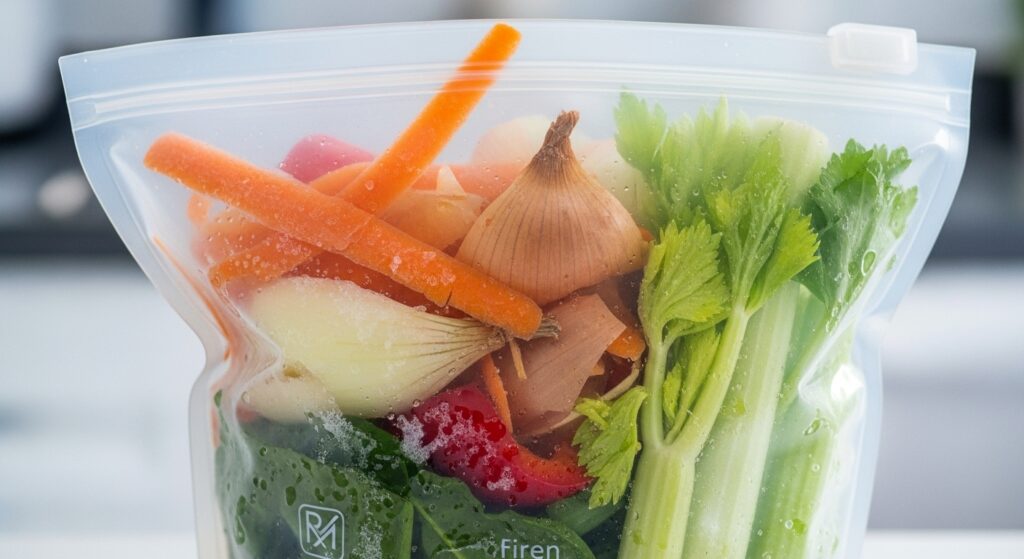
What I’ve found works best is using a reusable silicone freezer bag. It’s sturdy, washable, and you won’t be throwing away plastic to save food—that defeats the purpose!
What to Save (The “Gold”)
- Onion skins and ends (yellow or red—they add amazing color!)
- Carrot peels and ends
- Celery tops and bottoms
- Leek tops (the dark green parts)
- Garlic skins and ends
- Parsley and cilantro stems
- Mushroom stems
What to Avoid (The “Compost Pile”)
- Brassicas: Anything from the broccoli, cabbage, cauliflower, or Brussels sprout family. They will make your broth bitter and smell funky.
- Potato Peels: They make the broth cloudy and starchy.
- Anything Moldy or Rotten: This is key! We’re using scraps, not spoilage.
- Strong Flavors: Things like fennel or bell pepper can be overpowering, so add them only if you like that flavor.
Step 2: The Easiest Recipe (Just Add Water)
Once your scrap bag is full (usually after 2-3 weeks), it’s time to make magic.
Ingredients:
- 1 full freezer bag of assorted vegetable scraps
- A few “extras” (optional): a bay leaf, a few whole peppercorns, a sprig of thyme
- Cold water
Instructions:
- Empty your frozen scraps directly into a large stockpot. Don’t even thaw them.
- Add your optional extras (bay leaf, peppercorns).
- Pour in cold water until the scraps are just covered. Don’t add too much water, or the broth will be weak.
- Bring the pot to a boil, then immediately reduce the heat to a low simmer.
- Let it simmer gently, partially covered, for at least 1 hour, but no more than 2 hours.
- Pro Tip: Unlike meat broth, vegetable broth gets bitter if you cook it too long. 60-90 minutes is my sweet spot.
- Strain the broth through a fine-mesh sieve into a large bowl. Press the scraps gently to get all the liquid out.
- Compost the now-mushy scraps. Their life is complete!
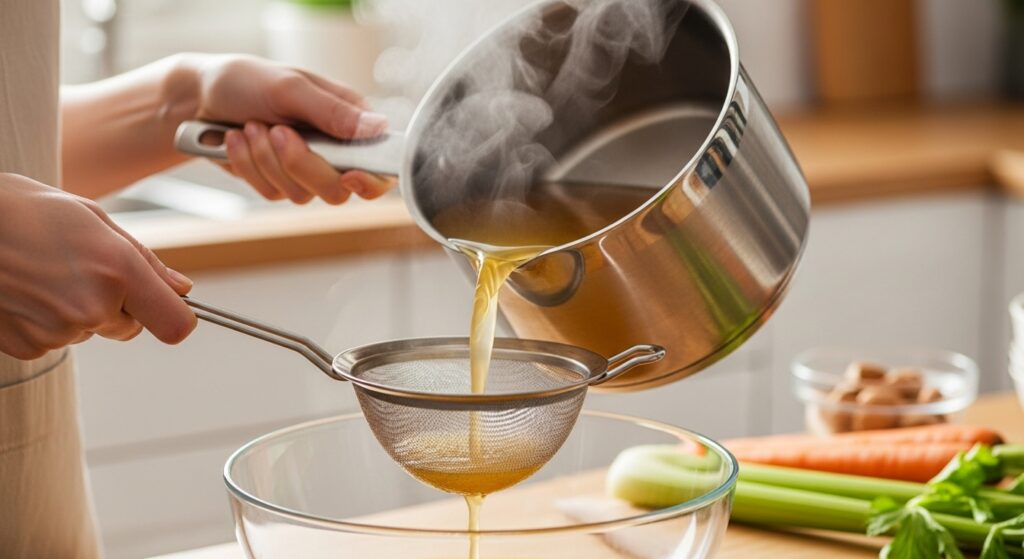
Step 3: How to Use Your Golden Broth (The Reward)
You just made a high-quality cooking base for free. Use it to:
- Make soups and stews
- Cook rice, quinoa, or risotto
- Deglaze a pan for a quick sauce
- Sip on its own as a warm, savory drink (it’s fantastic!)
Store it in jars in the fridge for up to a week or freeze it in ice cube trays for easy-to-use portions.
5 More Quick Zero Waste Recipe Ideas
Once you’ve mastered scrap broth, you’ll see opportunities everywhere. Here are a few more to try:
- Stale Bread Croutons: Don’t toss that hard-as-a-rock bread. Cube it, toss with olive oil and herbs, and bake at 375°F (190°C) until golden.
- Citrus Peel Cleaner: Stuff lemon or orange rinds into a jar and cover with white vinegar. Let it sit for 2 weeks. Strain, dilute 1:1 with water, and use as an all-purpose cleaner.
- “Fridge Clean-Out” Frittata: Got 2-3 eggs and a handful of wilting veggies or leftover cooked pasta? Whisk the eggs, sauté the veggies, and pour the eggs over top. Cook until set.
- Overripe Banana “Nice Cream”: Freeze those brown, mushy bananas (peeled!). Blend the frozen pieces with a splash of milk and a little vanilla for instant, healthy “ice cream.”
- Herb Stem Pesto: Don’t throw away parsley or cilantro stems! Blend them with garlic, nuts (or seeds), parmesan, and olive oil for a rustic, no-waste pesto. [Link to: 10 Creative Ways to Use Leftover Herbs]
My Top 3 Tips for a True No-Waste Kitchen
A zero-waste kitchen is built on habits, not just recipes.
- “First In, First Out” (FIFO): When you buy new groceries, move the old ones to the front of the fridge. This forces you to use them before they go bad.
- The “Eat Me First” Box: I keep a clear container in my fridge labeled “Eat Me First.” Any half-used onion, leftover roasted veggies, or yogurt cup goes in here. When I’m hungry for a snack, I check this box first.
- Learn Basic Preservation: Get comfortable with your freezer. Almost anything.
For a deeper dive into the impact of food waste, I highly recommend checking out the data from the U.S. Environmental Protection Agency (EPA). Seeing the numbers on a national scale really reinforces why these small habits matter so much.
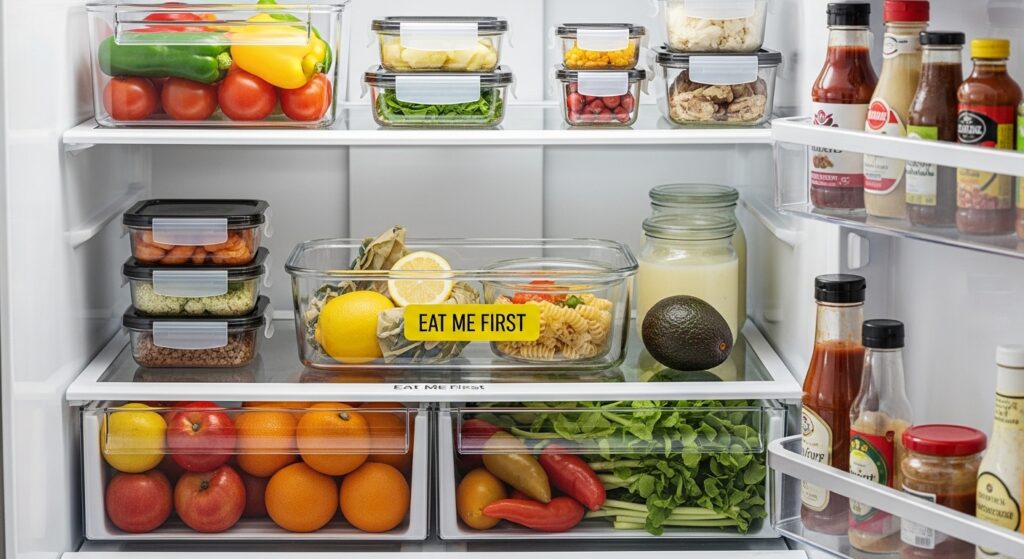
Frequently Asked Questions (FAQ)
What’s the easiest food scrap to reuse?
Vegetable scraps for broth are the easiest, no-fail starting point. The second easiest is stale bread for croutons or breadcrumbs. Both require minimal effort and have a high reward.
Is a 100% zero-waste kitchen realistic?
For most of us, 100% is not realistic, and that’s okay! The goal is progress, not perfection. Don’t let the “zero” in “zero waste” intimidate you. Reducing your food waste by 50% is a massive victory.
What’s the difference between zero waste and composting?
Composting is the last resort for food that can’t be eaten (like eggshells or the veggie scraps after you’ve made broth). The “zero waste” philosophy prioritizes using the food first. The mantra is: Reduce (buy less), Reuse (eat the scraps), then Recycle (compost).
Conclusion: Your “Recipycle” Journey Starts Now
The journey to a zero-waste kitchen doesn’t happen overnight. It starts with one small, intentional change.
By making this vegetable scrap broth, you’re not just making a recipe. You’re un-learning the habit of waste. You’re saving money, creating flavor from thin air, and doing something positive for the planet. That’s the core philosophy of “Recipycle.”
What’s the one food scrap you throw away most often? Let me know in the comments below, and let’s brainstorm a “recipycle” for it!
